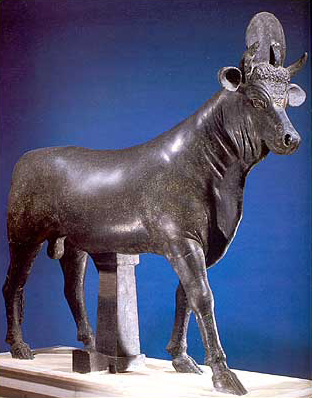
These two very special Pharaohs were possibly brothers or at the very least half brothers and together they mark the transition from and end of the Armana period. However, they both pose a mystery almost as great as that of Akhenaton. There is much physical evidence that pieces together a good mystery regarding Tutankhamon, including his actual body which to any detective is an essential element in the equation. As for Smenkhare we have a body and a tomb but very little else.
The young Smenkhare was the Co-regent of Akhenaton after the disappearance of Nefertiti but he reigned for only a few months after the ‘departure’ of his predecessor. The nine-year-old Tutankhamon succeeded him. He was more than likely a very close blood relative, possibly his brother, or at least half-brother. Influenced by the high priest Aye to change his name to Tutankhamon, he brought into effect the restoration of the old worship.
The mystery of Smenkhare is so bizarre that in reality it is perhaps the most horrible thing that could ever happen to an Ancient Egyptian. He was buried in a tomb without any inscriptions. Even his face was defaced and the cartouches on the mummyform coffin were removed. This meant that he was condemned to an existence for eternity in the tomb. He quite literally could not escape. Aye had ritually buried the Aton and entombed it forever.
It was more than likely that Smenkhare was murdered by the connivance of Aye and possibly Horemhab. However, there is even greater evidence for the murder of Tutankhamon by Aye, for he stole the young boy king’s tomb and forced his young widow to marry him so he could ascend the throne.
The reason for Tutankhamon's murder was that according to the evidence of his new throne that bore the sacred image of the Aton, he was reverting back to the worship of the Aton. As he reached adolescence he wanted to be free of the restraints placed upon him by the ageing Aye. He perhaps longed for the beauty and freedom of Armana where he undoubtedly spent his infancy and boyhood. That must have been paradise compared with the stuffy pomp of Thebes with the priests of Karnak wanting to rule the country through him in the name of Amon.
Tutankhamon was given a reasonably lavish burial in a hurriedly made vault in the Valley of the Kings. Howard Carter only found it because its entrance was used as a dumping ground for rubble during the construction of the nearby tomb for Horemhab who succeeded Aye after his short reign of 4 years.
What we must note is that very many of the artifacts found in the tomb of the boy king are in fact items belonging to his brother, Smenkhare. Compare the faces on the two coffin lids, they are totally different. The second, more elaborate one bears the features of Smenkhare whilst the solid gold coffin bears the likeness of its occupier Tutankhamon.
This would have been the work of the cunning Aye, not wanting to waste anything from the despoiled tomb of Smenkhare. He simply had the cartouches changed for the new recipient. A simple deception that ensured nothing went to waste, especially as very few people would ever see the middle of the three coffins, so as long as the solid gold innermost and the outermost coffins bore the real likeness then none would be any the wiser.
What a sad end for the two brothers; especially for the hardly known Smenkhare












